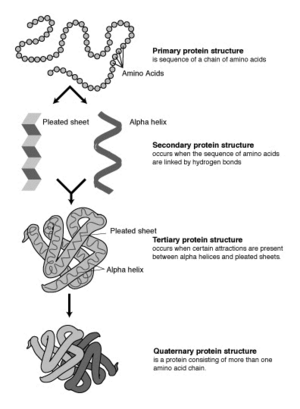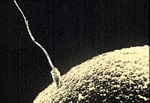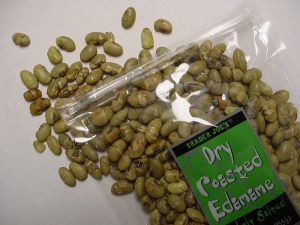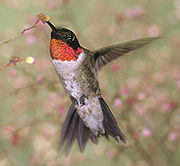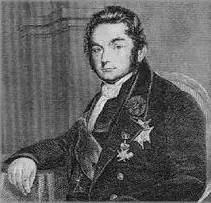Difference between revisions of "Protein" - New World Encyclopedia
| Line 2: | Line 2: | ||
[[Image:Myoglobin.png|thumb|200px|A representation of the three-dimensional structure of [[myoglobin]], the oxygen carrier in muscle. [[Max Perutz]] and [[John Kendrew|Sir John Cowdery Kendrew]] received a [[Nobel Prize in Chemistry]] for their eludicidation of myoglobin's structure in 1958; it was the first protein whose structure was solved using [[X-ray crystallography]]. The colored [[alpha helix|alpha helices]] represent myoglobin's ''secondary structure'' (discussed below).]] | [[Image:Myoglobin.png|thumb|200px|A representation of the three-dimensional structure of [[myoglobin]], the oxygen carrier in muscle. [[Max Perutz]] and [[John Kendrew|Sir John Cowdery Kendrew]] received a [[Nobel Prize in Chemistry]] for their eludicidation of myoglobin's structure in 1958; it was the first protein whose structure was solved using [[X-ray crystallography]]. The colored [[alpha helix|alpha helices]] represent myoglobin's ''secondary structure'' (discussed below).]] | ||
| − | + | A '''protein''' is a complex, high-molecular-mass, [[organic compound]] that consists of [[amino acid]]s joined together in long chains called [[polymer]]s. Alongside [[polysaccharide]]s, [[lipid]]s, and [[nucleic acid]]s, proteins are one of the major classes of [[macromolecules]] that make up the primary constituents of biological [[organism]]s. | |
| − | Different proteins perform a wide variety of biological functions | + | As suggested by the [[etymology]] of the term (from the [[Greek language|Greek]] word ''proteios'' meaning "of the first order"), proteins are of prime importance in the structure and function of all living [[cell (biology)|cells]] and [[virus]]es. Different proteins perform a wide variety of biological functions. Some proteins are [[enzyme]]s, [[catalyzing]] the chemical reactions in an organism. Other proteins play structural or mechanical roles, such as those that form the struts and joints of the [[cytoskeleton]], which is like a system of [[scaffolding]] within a cell. Still others, such as [[antibodies]], are able to identify and neutralize foreign substances like [[bacteria]] and viruses. |
| − | |||
| − | |||
| − | |||
| − | |||
| − | + | Dietary protein is essential for the survival of [[animals]]. Unlike [[plant]]s, which are able to synthesize the amino acids that they require, animals cannot synthesize all of the 20 [[standard amino acids]] necessary for normal functioning. The amino acids required by the diet are known as [[essential amino acid]]s, though their specific number and type vary among [[species]]. | |
| − | + | Discovered by [[Jöns Jakob Berzelius]] in 1838, proteins are among the most actively-studied [[molecule]]s in [[biochemistry]]. Determining a protein's unique amino acid sequence, which governs its three-dimensional structure, is of particular interest. These sequences can provide insight into the rules that govern protein folding into three-dimensional shapes (as well as an understanding why proteins misfold, as in [[Alzheimer's disease]]). Charting the amino acid sequences of proteins contributes to an understanding of the history of early life, as proteins resemble one another in sequence only if they evolved from a common ancestor.It is also helpful in the study and treatment of disease, since a change to a single amino acid in a single protein (which often reflects a [[mutation]] in a particular gene) can result in diseases such as [[sickle-cell anemia]] and [[cystic fibrosis]]. | |
| − | |||
| − | |||
==The structure of proteins== | ==The structure of proteins== | ||
| Line 54: | Line 48: | ||
==Proteins in the human diet== | ==Proteins in the human diet== | ||
| + | ===Sources of protein=== | ||
[[Image:Trader joes edamame.jpg|thumb|left|Soybeans are a good source of essential amino acids.]] | [[Image:Trader joes edamame.jpg|thumb|left|Soybeans are a good source of essential amino acids.]] | ||
| − | Protein is an important [[macronutrient]] to the human diet, supplying the body's needs for amino acids, the | + | Protein is an important [[macronutrient]] to the human diet, supplying the body's needs for amino acids, particularly the ''essential amino acids'' that humans are unable to synthesize. Between 8 and 10 amino acids are considered essential in humans. |
While animal meats are rich sources of this vital dietary element, protein is also found in plant foods, such as grains and legumes, and in eggs and dairy products, such as milk and yogurt. The best way to obtain the full range of essential amino acids is to consume a variety of protein-rich foods. [[Soy]] products such as [[tofu]] are particularly important to many [[Vegetarianism|vegetarians]] and [[Veganism|vegans]] as a source of [[protein#Protein and nutrition|complete protein]] (a protein that contains significant amounts of all the essential amino acids). | While animal meats are rich sources of this vital dietary element, protein is also found in plant foods, such as grains and legumes, and in eggs and dairy products, such as milk and yogurt. The best way to obtain the full range of essential amino acids is to consume a variety of protein-rich foods. [[Soy]] products such as [[tofu]] are particularly important to many [[Vegetarianism|vegetarians]] and [[Veganism|vegans]] as a source of [[protein#Protein and nutrition|complete protein]] (a protein that contains significant amounts of all the essential amino acids). | ||
| Line 73: | Line 68: | ||
==Studying proteins== | ==Studying proteins== | ||
[[Image:Jöns_Jacob_Berzelius.png|thumb|Jöns Jakob Berzelius]] | [[Image:Jöns_Jacob_Berzelius.png|thumb|Jöns Jakob Berzelius]] | ||
| − | The first mention of the word ''protein'' was from a letter sent by the Swedish chemist | + | The first mention of the word ''protein'' was from a letter sent by the Swedish chemist Jöns Jakob Berzelius to [[Gerhardus Johannes Mulder]] on July 10, 1838. He wrote: |
: «Le nom protéine que je vous propose pour l’oxyde organique de la fibrine et de l’albumine, je voulais le dériver de πρωτειος, parce qu’il paraît être la substance primitive ou principale de la nutrition animale.» | : «Le nom protéine que je vous propose pour l’oxyde organique de la fibrine et de l’albumine, je voulais le dériver de πρωτειος, parce qu’il paraît être la substance primitive ou principale de la nutrition animale.» | ||
| Line 79: | Line 74: | ||
Translated as: | Translated as: | ||
| − | : "The name protein that I propose for the organic oxide of [[fibrin]] and [[albumin]], I wanted to derive from | + | : "The name protein that I propose for the organic oxide of [[fibrin]] and [[albumin]], I wanted to derive from the Greek word πρωτειος, because it appears to be the primitive or principal substance of animal nutrition." |
| − | |||
| − | |||
| − | + | One of the more striking discoveries of the 20th century was that the native and [[denatured]] states in many proteins were interconvertible ('''denatured''' refers to a protein that is not in its native state and is generally lacking a well-defined secondary structure). That is, by careful control of solution conditions (by for example, [[dialysis|dialyzing]] away a denaturing chemical), a denatured protein could be converted to its native form. The question of how proteins arrive at their native state is an important area of biochemistry, called the study of [[protein folding]]. | |
| − | + | Through [[genetic engineering]], researchers can alter the amino acid sequence and hence the structure, [[protein targeting|targeting]], susceptibility to regulation, and other properties of a protein. The genetic sequences of different proteins may be spliced together to create [[chimera (protein)|chimeric]] proteins that possess properties of both. This form of tinkering represents one of the chief tools of cell and molecular biologists to change and to probe the workings of cells. Another area of protein research attempts to engineer proteins with entirely new properties or functions, a field known as [[protein engineering]]. | |
== References == | == References == | ||
Revision as of 01:50, 23 August 2006
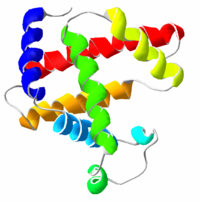
A protein is a complex, high-molecular-mass, organic compound that consists of amino acids joined together in long chains called polymers. Alongside polysaccharides, lipids, and nucleic acids, proteins are one of the major classes of macromolecules that make up the primary constituents of biological organisms.
As suggested by the etymology of the term (from the Greek word proteios meaning "of the first order"), proteins are of prime importance in the structure and function of all living cells and viruses. Different proteins perform a wide variety of biological functions. Some proteins are enzymes, catalyzing the chemical reactions in an organism. Other proteins play structural or mechanical roles, such as those that form the struts and joints of the cytoskeleton, which is like a system of scaffolding within a cell. Still others, such as antibodies, are able to identify and neutralize foreign substances like bacteria and viruses.
Dietary protein is essential for the survival of animals. Unlike plants, which are able to synthesize the amino acids that they require, animals cannot synthesize all of the 20 standard amino acids necessary for normal functioning. The amino acids required by the diet are known as essential amino acids, though their specific number and type vary among species.
Discovered by Jöns Jakob Berzelius in 1838, proteins are among the most actively-studied molecules in biochemistry. Determining a protein's unique amino acid sequence, which governs its three-dimensional structure, is of particular interest. These sequences can provide insight into the rules that govern protein folding into three-dimensional shapes (as well as an understanding why proteins misfold, as in Alzheimer's disease). Charting the amino acid sequences of proteins contributes to an understanding of the history of early life, as proteins resemble one another in sequence only if they evolved from a common ancestor.It is also helpful in the study and treatment of disease, since a change to a single amino acid in a single protein (which often reflects a mutation in a particular gene) can result in diseases such as sickle-cell anemia and cystic fibrosis.
The structure of proteins
Components and synthesis
Proteins are built from combinations of 20 different amino acids, which are organic molecules composed of an amino group (-NH2), a carboxylic acid group (-COOH), and a unique R group, or side chain. Two amino acids (specifically, L-alpha-amino acids) are linked together by a peptide bond, which forms when the amino group of one amino acid reacts with the carboxyl group of a second amino acid. An amino acid residue is what is left of an amino acid once it has coupled with another amino acid to form a peptide bond.
Proteins are then created by the polymerization of amino acids, a process in which amino acids are joined together in chains. Proteins are generally large molecules (e.g., the muscle protein titin has a single amino acid chain 27,000 subunits long). Such long chains of amino acids are almost universally referred to as proteins, but shorter strings of amino acids may be referred to as "polypeptides," "peptides" or rarely, "oligopeptides". The variety of protein sizes contributes to their functional diversity—for instance, a shorter amino acid chain may be more likely to act as a hormone (like insulin), rather than as an enzyme (which depends on its defined three-dimensional structure for functionality).
Amino acid sequence is the link between the genetic code and the three-dimensional structure of proteins that determines their function. Proteins are assembled from amino acids using information present in genes. This information is encoded in a different chemical language, however: the language of nucleotides, the components of the nucleic acid DNA. Genes are first transcribed into RNA, another nucleic acid. RNA is then subject to post-transcriptional modification and control, resulting in a mature mRNA that undergoes translation into a protein (i.e., the copy is translated from the language of nucleotides to that of amino acids). In many cases, the resulting protein is them chemically altered (post-translational modification) before becoming functional.
The four levels of protein structure
Proteins fold into unique three-dimensional structures. The shape into which a protein naturally folds is known as its native state, which is determined by its sequence of amino acids. Sometimes, however, proteins do not fold properly. When proteins misfold, it can lead to illnesses such as Alzheimer’s disease, in which brain function is limited by deposits of proteins that have misfolded and can no longer perform their functions. A full understanding of why protein misfolding occurs might lead to advances in the treatment of diseases like Alzheimer’s.
Biochemists refer to four distinct aspects of a protein's structure:
- Primary structure is the linear amino acid sequence encoded by DNA. Any error in this sequence, such as the substitution of one amino acid residue for another, may lead to a congenital disease.
- Secondary structures are highly patterned sub-structures that form in the interaction of amino acid residues near to each other on the chain. The most common are the alpha helix and the beta sheet. Secondary structures are defined, meaning that there can be many different secondary motifs present in one single protein molecule.
- Tertiary structure refers to the overall, three-dimensional shape of a single protein molecule. This spatial relationship of amino acid residues that are far apart on the sequence is primarily formed by hydrophobic interactions, though hydrogen bonds, ionic interactions, and disulfide bonds are usually involved as well.
- Some proteins may have a quaternary structure, i.e., the shape or structure that results from the union of more than one protein molecule (called ‘’subunits’’ in this context) which function as part of the larger assembly, or protein complex. Hemoglobin, which serves as an oxygen carrier in blood, has a quaternary structure of four subunits.
In addition to these levels of structure, proteins may shift between several similar structures in performing their biological function. In the context of these functional rearrangements, tertiary or quaternary structures are usually referred to as "conformations," and transitions between them are called conformational changes. Although any unique polypeptide may have more than one stable folded conformation, each conformation has its own biological activity and only one conformation is considered to be the active one. This assumption has been recently challenged by the discovery of intrinsically unstructured proteins, which can fold in multiple structures with different biological activity.
Major functions of proteins
Proteins are involved in practically every function performed by a cell, including regulation of cellular functions such as signal transduction and metabolism. However, several major classes of proteins may be identified based on the functions below:
- Enzyme catalysis. Nearly all of the chemical reactions in living organisms—from the initial breakdown of food nutrients in the saliva to the replication of DNA—are catalyzed by proteins.
- Transport and storage. Membrane-associated proteins move their substrates (such as small molecules and ions) from place to place without altering their chemical properties. E.g., the protein hemoglobin (pictured above) transports oxygen in blood.
- Immune protection. Antibodies, the basis of the adaptive immune system, are soluble proteins capable of recognizing and combining with foreign substances. This class also includes toxins, which play a defensive role (e.g., the dendrotoxins of snakes).
- Signaling. Receptors mediate the responses of nerve cells to specific stimuli. Rhodopsin, for example, is a light sensitive protein in the rod cells of the retina of vertebrates.
- Structural support. Examples include tubulin, actin, collagen and keratin, which are important strengthening components of skin, hair, and bone.
- Coordinated motion. Another special class of proteins consists of motor proteins such as myosin, kinesin, and dynein. These proteins are "molecular motors," generating physical force which can move organelles, cells, and entire muscles. Proteins are the major components of muscle, and muscle contraction involves the sliding motion of two kinds of protein filaments. At the microscopic level, the propulsion of sperm by flagella is produced by protein assemblies.
- Control of growth and differentiation. In higher organisms, growth factor proteins such as insulin control the growth and differentiation of cells. Transcription factors regulate the activation of transcription in the eukaryotes, while cyclins that regulate the cell cycle, the series of events in a eukaryotic cell between one cell division and the next.
Proteins in the human diet
Sources of protein
Protein is an important macronutrient to the human diet, supplying the body's needs for amino acids, particularly the essential amino acids that humans are unable to synthesize. Between 8 and 10 amino acids are considered essential in humans.
While animal meats are rich sources of this vital dietary element, protein is also found in plant foods, such as grains and legumes, and in eggs and dairy products, such as milk and yogurt. The best way to obtain the full range of essential amino acids is to consume a variety of protein-rich foods. Soy products such as tofu are particularly important to many vegetarians and vegans as a source of complete protein (a protein that contains significant amounts of all the essential amino acids).
The exact amount of dietary protein needed to satisfy protein requirements for humans, known as an RDA, may vary widely depending on age, sex, level of physical activity, and medical condition.
Protein deficiency and dietary imbalance
Protein deficiency can lead to symptoms such as fatigue, insulin resistance, hair loss, loss of hair pigment, loss of muscle mass, low body temperature, hormonal irregularities, and loss of skin elasticity.
However, given the central importance of proteins to life, and the importance of strong muscles for survival in particular, animals are designed to minimize the loss of protein from muscle during a period of starvation. When dietary proteins and carbohydrates are deficient, proteins may be broken down to synthesize glucose to supply organs, like the brain, that normally utilize glucose as a fuel. However, over a period of days, the body’s metabolism switches to the breakdown of ‘’fats’’, the storage form of fatty acids, which can be precursors for ketone bodies, an alternative fuel for the brain. This mechanism also works to the advantage of migratory birds, such as the ruby-throated hummingbird, who build-up their fat stores before journeying long distances over water. The brain’s transition from glucose to ketone bodies occurs quite rapidly, so that hardly any protein in muscle is lost, enabling them to make their arduous, 2400 km flight.
Excessive protein intake may be linked to some health problems:
- Liver dysfunction due to increased toxic residues. Because the body is unable to store excess protein, it is broken down and converted into sugars or fatty acids. The liver removes nitrogen from the amino acids, so that they can be burned as fuel, and the nitrogen is incorporated into urea, the substance that is excreted by the kidneys. These organs can normally cope with any extra workload but if kidney disease occurs, a decrease in protein will often be prescribed.
- Loss of bone density, as calcium and glutamine are leached from bone and muscle tissue to balance increased acid intake from the diet. This effect is not present if intake of alkaline minerals is high. In such cases, protein intake helps to strengthen bones.
Studying proteins
The first mention of the word protein was from a letter sent by the Swedish chemist Jöns Jakob Berzelius to Gerhardus Johannes Mulder on July 10, 1838. He wrote:
- «Le nom protéine que je vous propose pour l’oxyde organique de la fibrine et de l’albumine, je voulais le dériver de πρωτειος, parce qu’il paraît être la substance primitive ou principale de la nutrition animale.»
Translated as:
- "The name protein that I propose for the organic oxide of fibrin and albumin, I wanted to derive from the Greek word πρωτειος, because it appears to be the primitive or principal substance of animal nutrition."
One of the more striking discoveries of the 20th century was that the native and denatured states in many proteins were interconvertible (denatured refers to a protein that is not in its native state and is generally lacking a well-defined secondary structure). That is, by careful control of solution conditions (by for example, dialyzing away a denaturing chemical), a denatured protein could be converted to its native form. The question of how proteins arrive at their native state is an important area of biochemistry, called the study of protein folding.
Through genetic engineering, researchers can alter the amino acid sequence and hence the structure, targeting, susceptibility to regulation, and other properties of a protein. The genetic sequences of different proteins may be spliced together to create chimeric proteins that possess properties of both. This form of tinkering represents one of the chief tools of cell and molecular biologists to change and to probe the workings of cells. Another area of protein research attempts to engineer proteins with entirely new properties or functions, a field known as protein engineering.
ReferencesISBN links support NWE through referral fees
- Atkins, Peter and Loretta Jones. 2005. Chemical Principles, 3rd edition. New York, NY: W.H. Freeman.
- Stryer, Lubert. 1995. Biochemistry, 4th edition. New York, NY: W.H. Freeman.
External links
- The Protein Databank
- UniProt the Universal Protein Resource
- Human Protein Atlas
- iHOP - Information Hyperlinked over Proteins
- Proteins: Biogenesis to Degradation - The Virtual Library of Biochemistry and Cell Biology
- MIT's Laboratory for Protein Molecular Self-Assembly
- Numerous publications on synthetic biomimetic protein-based biomaterials
- Amino acid metabolism
- Protein Images
- Online Protein viewer with a local PDB database
- NCBI Entrez Protein database
- NCBI Protein Structure database
- TheDailyPlate.com - Protein content details for over 100,000 foods.
- AOAC International
Credits
New World Encyclopedia writers and editors rewrote and completed the Wikipedia article in accordance with New World Encyclopedia standards. This article abides by terms of the Creative Commons CC-by-sa 3.0 License (CC-by-sa), which may be used and disseminated with proper attribution. Credit is due under the terms of this license that can reference both the New World Encyclopedia contributors and the selfless volunteer contributors of the Wikimedia Foundation. To cite this article click here for a list of acceptable citing formats.The history of earlier contributions by wikipedians is accessible to researchers here:
The history of this article since it was imported to New World Encyclopedia:
Note: Some restrictions may apply to use of individual images which are separately licensed.

